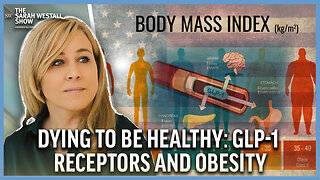Premium Only Content

FORMER ROMAN CATHOLIC "BRIDE OF CHRIST" NUN TESTIFIES OF ABNORMAL LIFE IN THE CONVENT
This presentation features Richard Bennett, a former Roman Catholic Dominican priest for 22 years & a Roman Catholic for 48 years interviewing former Benedictine nun Mary Ann Pakiz who, according to Roman Catholic theology, was a "Bride of Christ" following the "Rule of Saint Benedict" (The Rule of Saint Benedict (Regula Benedicti) is a book of precepts written by St. Benedict of Nursia for monks living communally under the authority of an abbot. Since about the 7th century it has also been adopted by communities of women. During the 1500 years of its existence, it has become the leading guide in Western Christianity for monastic living in community. The spirit of St Benedict's Rule is summed up in the motto of the Benedictine Confederation: pax ("peace") and the traditional ora et labora ("pray and work").).
The Benedictine Sisters of Perpetual Adoration are a congregation of nuns within the Benedictine Confederation. The original monastery was founded in 1874 by a group of five nuns, led by Sister Mary Anselma Felber, O.S.B., who came from the young monastery of Maria-Rickenbach (founded 1857) in Switzerland. Arriving in Clyde, Missouri, they founded the Benedictine Convent of Perpetual Adoration. This remains the motherhouse and largest community of the congregation. It houses 550 documented relics of the saints—the biggest such collection in the United States. The decision to come was sparked by the departure of a group of monks from the nearby Engelberg Abbey, at a time when monastic communities felt threatened by political changes taking place throughout Europe. As with many other monastic groups, they looked to the New World for a place of refuge.The monks went on to found Conception Abbey in nearby Conception, Missouri, and began to minister to German and Irish immigrants of the region. The nuns follow a simple, contemplative way of life, formed by the Rule of St. Benedict. To this end, they supported themselves by such farming as could be done on their land. They also provide the printing of spiritual cards, as well as making vestments for churches around the country, and the baking of Altar Breads. To the usual monastic routine, they have added the practice of Perpetual Adoration in their chapels.
Roman Catholic nuns, similar in tradition to ancient Rome's "vestal virgins" (the Vestals or Vestal Virgins (Vestales, singular Vestalis), were priestesses of Vesta, goddess of the hearth. The Vestals were freed of the usual social obligations to marry and bear children, and took a vow of chastity in order to devote themselves to the study and correct observance of state rituals) or Buddhist nuns, think their ascetic lifestyle will earn them eternal salvation. Even Mother Teresa felt the emptiness of this type of "works to earn salvation" writing, "How cold—how empty—how painful is my heart.—Holy communion—Holy Mass—all the holy things of spiritual life—of the life of Christ in me—are all so empty—so cold—so un-wanted. The physical situation of my poor, left in the streets unwanted, unloved, un-claimed—are the true picture of my own spiritual life, of my love for Jesus...." (Letter to Fr. Neuner, May 12, 1962, Mother Teresa, p. 232).
True Christian believers have the "Spirit of truth" (John 14:17) and through that Spirit, a vital bond of union with Jesus Christ. If anyone has Christ as Savior, he or she has the Holy Spirit as Indweller (1 Corinthians 6:19-20). Anyone who claims to belong to Jesus Christ but gives no evidence of being indwelt by the Holy Spirit lacks the indisputable proof to establish his or her claim. No test could be more easily applied and none is more decisive, as Scripture explains; "now if any man have not the Spirit of Christ, he is none of His" (Romans 8:9). The consolation of the Holy Spirit is so basic to Christian life that the Apostle Paul calls it "everlasting consolation;" (2 Thess 2:16). Eternal redemption, and the everlasting life is found in the Gospel of grace (Ephesians 2:8-10). Thus living in a monastery or convent is unnecessary & using relics, praying to Mary, or following ascetic rules & rituals believing it will lead to salvation is worthless (Galatians 1:6-9).
-
 1:19:05
1:19:05
Christian Answers
1 year agoPfizer Director Says Covid is Cash Cow, Side Effects Revealed
3181 -
 9:49
9:49
Tundra Tactical
3 hours ago $0.41 earnedThe Best Tundra Clips from 2024 Part 1.
2.57K1 -
 1:05:19
1:05:19
Sarah Westall
3 hours agoDying to Be Thin: Ozempic & Obesity, Shedding Massive Weight Safely Using GLP-1 Receptors, Dr. Kazer
3.16K5 -

LFA TV
1 day agoThe Resistance Is Gone | Trumpet Daily 12.26.24 7PM EST
4.98K2 -
 DVR
DVR
theDaily302
12 hours agoThe Daily 302- Tim Ballard
6.01K1 -
 13:22
13:22
Stephen Gardner
5 hours ago🔥You'll NEVER Believe what Trump wants NOW!!
60.8K174 -
 54:56
54:56
Digital Social Hour
1 day ago $7.51 earnedDOGE, Deep State, Drones & Charlie Kirk | Donald Trump Jr.
29.2K2 -
 DVR
DVR
The Trish Regan Show
7 hours agoTrump‘s FCC Targets Disney CEO Bob Iger Over ABC News Alleged Misconduct
37.5K34 -
 1:48:19
1:48:19
The Quartering
7 hours agoElon Calls White People Dumb, Vivek Calls American's Lazy & Why Modern Christmas Movies Suck!
120K98 -
 2:08:42
2:08:42
The Dilley Show
8 hours ago $32.37 earnedH1B Visa Debate, Culture and More! w/Author Brenden Dilley 12/26/2024
108K24